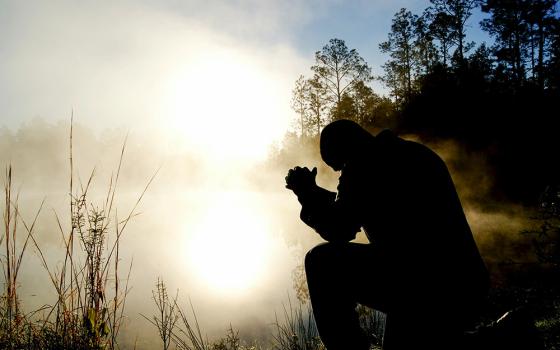I was walking with friends through downtown Columbus, Ohio, one day a few years ago when the sky suddenly turned cloudy.
"Sweet black, dreadlocked Jesus, please don't let it rain until I finish my set," one of my friends, who was performing later in an outdoor festival, pleaded to the air.
" 'Black, dreadlocked Jesus?' " I asked in between laughs and my classic "You are so stupid" stare.
My friend went on to explain that in his personal theology, Jesus had tiers. The white Jesus -- that is, the Christ that Leonardo da Vinci painted in his depiction of the Last Supper -- was the Jesus you pray to for trivial matters, like a good grade on a test. Black, dreadlocked Jesus manipulated earth, wind, fire and water. He was for the elements, the big stuff.
My friend also referred to the white Jesus as "the one whose picture is framed and hanging on the wall in Grandmama's house." Evidently, my friend and I had similar upbringings. The painting of "Jesus Christ" in my grandmother's house was the kind that had two paintings in one. You looked at Jesus one way and his head was bowed; you turned your head, and his head was repositioned to look up at God. No matter which way your or his head was turned, he looked like da Vinci's Christ -- a fair-skinned Italian with long, well-conditioned brown or blonde hair and blue eyes.
I don't think I noticed Christ's race in that painting until one of my aunts, home from college where she was studying anthropology, said something like, "Why is that picture of a white Jesus still on the wall?" I don't mean to say I was "color blind" or that Christ's race didn't matter to me as long as he saved my soul. I'm not sure I had accepted Christ as my personal savior when she said that, so the latter is improbable. Color blindness wasn't the case for someone well aware she was the "only one" in her advanced program classes, Girl Scout troop and dance class. I likely just didn't notice Jesus' ethnicity in that painting because he looked like almost everyone else I was used to being around almost all of the time. White people -- in my classes and activities, on the television shows I watched, in the magazines I read -- were ubiquitous and the norm.
That was Aisha Harris' point when she wrote the much talked-about Slate op-ed calling for an end to the representation of Santa Claus as an old white man. Reacting to Harris' article, Fox News anchor Megyn Kelly made two unequivocal declarations: "Santa just is white," and "Jesus was a white man, too." (See video in previous link.)
I'll skip how problematic it is to put Santa and Jesus on the same level. I have yet to see a blog post with a Christian up in arms about how equating a mythical character who delivers toys and stuff off a wish list with Jesus Christ, who saves souls, is reflective of how caught up in consumerist culture we've become. But I'll skip that. Kelly has been thoroughly mocked and her belief in Jesus's whiteness as thoroughly debunked, so I won't repeat those arguments, either.
I do want to point out the white supremacist nature of Kelly's comments. First, even if she was just joking, her insistence on Christ being a white man -- and even her claiming the mythical Santa's white origins -- is an example of cultural appropriation, meaning white people taking credit for things they didn't do or drastically altering them to make white audiences more comfortable. Kelly later indicated Jesus' suspected dark hue was new information to her, but ignorance doesn't change the issue. If white people had never appropriated Christ's image, then the myth of a white Jesus wouldn't have been so pervasive that Kelley didn't know better.
Second, people of color all over the world are told -- directly and through white ubiquitousness -- that white is the norm, everything about white people is better, and anything dark is inherently bad. If the only sinless and therefore most perfect man to ever walk the planet is white, that seals it: Whiteness -- although at least in skin color is unattainable unless born white -- is what we should all aspire to.
Which is why, even though it's just as inaccurate as a "Scandinavian supermodel" Jesus, I like my friend's "sweet, black, dreadlocked Jesus." It's why I enjoy giving and receiving Christmas cards with a regal, African Mary and Joseph holding a brown baby Jesus. It's why, when a woman at my church said of the brown-skinned man with dreadlocks cast as Christ in the Easter play, "He looked just Jesus, didn't he!" I rolled my eyes and said, "So she was roaming the earth with Jesus 2,000 years ago?" but felt comforted at the same time.
I felt good because I know what it's like to have to constantly reframe the messages you receive, to tell yourself you don't need to aspire to be either something else or something unattainable. No one will ever be sinless; that's why we need Christ. But if the most perfect man to ever live is African-American, if he's already like me, he has proven there is good in me, that better lies within me, and that better is attainable.
[Mariam Williams is a writer born and raised in Louisville, Ky., where she's received numerous arts awards. When not working in the field of social justice research and taking graduate courses in women and gender and Pan-African studies, she blogs at RedboneAfropuff.com. Follow her on Twitter: @missmariamw.]
Editor's note: We can send you an email alert every time Mariam Williams' column, "At the Intersection," is posted to NCRonline.org. Go to this page and follow directions: Email alert sign-up.



